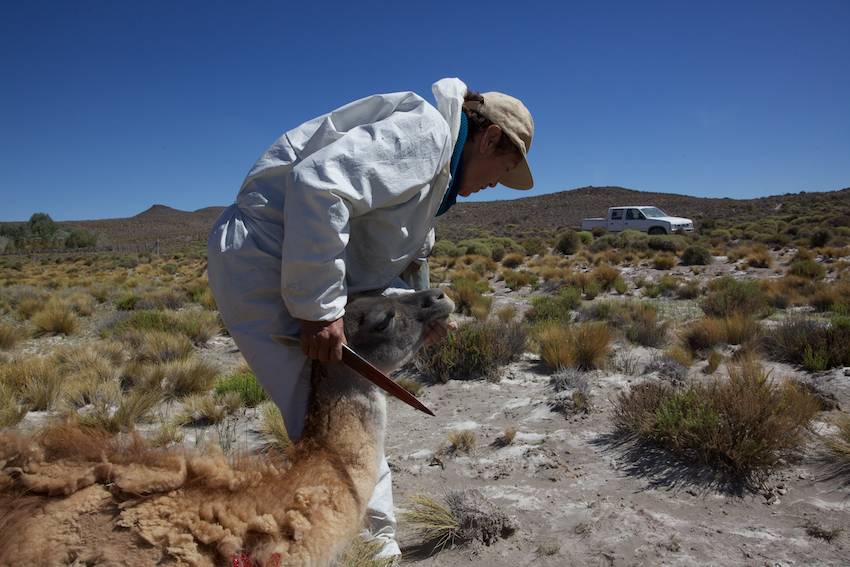A year earlier, I had driven out to a ranch outside of Jacobacci called Estancia Yuquiche. I knew from Google Earth that the ranch had some interesting canyons and wetlands so I just showed up and asked if I could wander around. After an incredibly awkward introduction, the owner agreed to host me at her ranch house. That’s how I met Carmen Crespo, the 67-year old grandmother of Valentin and Camila. The week I spent there was one of the most memorable of my life.
As you can imagine, I was really looking forward to going back. Carmen picked me up from Jacobacci and we drove out to her ranch a few days before Christmas. She was born to a poor family who had little more than a stone hut and a small flock of goats. She married the owner of Estancia Yuquiche at a young age and despite the gender roles that predominate gaucho culture, she participated in every aspect of running the ranch. She took over after her husband died and now looks after her flock of 4000 sheep with the help of one gaucho (cowboy).
Julio feeds the ewes and lambs at sunrise. Normally the sheep would be out grazing, but because of greater predation pressure from foxes, ranchers have to keep their animals in protective corrals and feed them expensive store-bought grain.
At least, it used to be 4000 sheep. When the ash first came down, it smothered the vegetation and half of Carmen’s flock died of starvation. She sold off as many remaining animals as possible because she didn’t know how long she could afford to feed them. There is no such thing as a feedlot in Patagonia so supplemental grain and alfalfa is prohibitively expensive for most ranchers and completely unregulated. Carmen had always relied on her land to sustain her sheep so now, when animals grew sick, she had no way to know if it was from contaminants in the feed or from some other cause.
A sick ewe stands next to one that died of illness the night before. Carmens suspects contaminants in the feed could be to blame.
Getting ready to ride out with Julio for a survey of the ranch
Wind remobilizes the ash and turns the landscape grey
Julio roasts a rack of lamb in a typical gaucho asado, or barbecue
A kite's eye view of Estancia Yuquiche
Another kite's eye view of the ranch. The white you see is ash that has settled into the grassland. It may be acting as a moisture barrier and preventing the soil from drying out.
I watched a furry brown creature go down 100 yards away. I was wide-eyed and still processing when Julio yelled “Another one! Another one! Get it!”
BLAM!
Another furry animal crumpled in the distance. Oh shit! Was this really happening?! Carmen pulled the truck off the road and headed straight for the two guanaco still kicking in the dirt. She stopped next to the first one, produced a huge knife (again, out of nowhere) and stabbed it in the neck. Blood gushed everywhere and the guanaco started to froth and gurgle. Carmen didn’t wait for it to die before disemboweling it. The guanaco’s heart continued to pound even as the rest of its organs lay strewn over the ground. Oh SHIT! Ok I admit I eat meat and I guess this is how it’s done, but dang this was a bit much! I couldn’t help but stare into the animal’s enormous glassy eyes as the last bit of life shuddered through its body. It was then that I noticed the baby guanaco staring back at us from 20ft away. It watched and whimpered as Carmen walked over to the second adult, slit its throat, and ripped its guts out with her bare hands.
| Carmen spots a guanaco in the distance and takes it down with her rifle |
| Carmen finishes off the guanaco by stabbing it in the neck |
The lambs had to be separated from their mothers early this year because Carmen couldn't afford the cost of their feed. She is injecting them with supplemental vitamins and hoping they will not get sick. When the syringe gets clogged with blood and skin, she cleans it out with her teeth.
Not wanting to overstay my welcome, I left on the day before Chrismas Eve. The youngest lamb had lost his mother and couldn’t be left unattended at the ranch, so he rode on my lap on the way back to Jacobacci. This was all very cute and cuddly right until he peed all over me and my last pair of clean pants. Probably should have seen that coming…
Feeding a couple of orphaned lambs. This turned out to be a mistake because afterwards, they identified me as a source of food. It was impossible to work with these two around as they constantly harassed me, demanding to be fed.
We stopped by the family’s place to say goodbye and drop off the lamb for Camila to play with. When Carmen asked what his name should be, Camila looked up with a smile and said “Hanand!”
Camila and her new friend, Hanand the lamb













Hi Anand:
ReplyDeleteLove reading your adventures all over the world. What an experience!
Keep it up.
Vivek Uncle
Hola Anand està muy bueno tu relato, muchas gracias por contar nuestra historia. Te esperamos!!!!! lloviò algo y los pastos estàn altos, hay mucha esperanza.
ReplyDeleteCamila y Valentin siempre te recuerdan, cada vez que ven un insecto lo estudian con la lupa y dicen "Soy Anand". Creo que dejaste un buen mensaje en nuestros hijos.
Saludos de Carmen.
abrazos Lili y Fermín